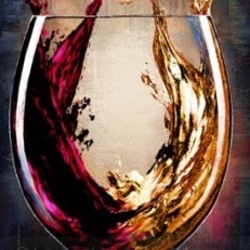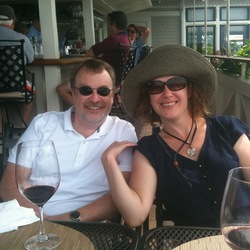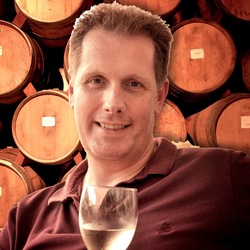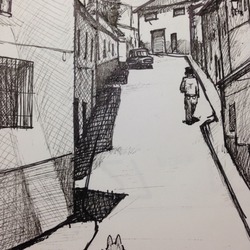Barrel Run Crossing
Philip Togni Vineyard
Napa Valley Cabernet Sauvignon 1992
One of my favorite Napa producers & vintages from Philip Togni.
On the nose, ripe, perfumed florals, creamy fruits of; blackberries, mulberries, dark cherries, black raspberries, raspberries, plum and strawberries on the glass edges. Vibrant baking spices; vanilla, light cinnamon, clove & nutmeg. Dark smooth spices, mocha chocolate with caramel, dark berry cola, notes of black licorice, sweet tar, forest floral, fresh tobacco leaf, just a touch of dry herbs, graphite, loamy clay and dark, fresh red florals with lavender & violets.
The body is, round, ruby, lush & full. The structure, tension, length have just tipped to the very beginnings of the waning stage but, the balance is incredible. Ripe, perfumed florals, creamy fruits of; blackberries, mulberries, dark cherries, black raspberries, raspberries, plum and strawberries on the glass edges. Vibrant baking spices; vanilla, light cinnamon, clove & nutmeg. Dark smooth spices, mocha chocolate with caramel, dark berry cola, chalky volcanic minerals with some grit, crushed dry rocks, notes of black licorice, sweet tar, forest floral, tobacco with ash, soft leather, saddle-wood, some underbrush, just a touch of dry herbs, graphite, loamy clay and dark, fresh red florals with lavender & violets. The round acidity is near perfect. The long, round, ripe, ruby, lush, well balanced finish sings on the palate for minutes.
Photos of, the Philip Togni vineyard, cellar staff-Salvador Sanchez, Philip Togni and his daughter Lisa and their barrel room.
Producer notes and history...Philip Togni was born in England and earned a degree (the Dipome National d’Oenologie) at the University of Bordeaux under Emile Peynaud. World famous Winemaker & mega Wine Consultant Michel Rolland also studied under Emile.
After his studies, Philip Togni moved to the Napa Valley in 1959. His first job was planting vines at Mayacamas.
In his career, he has been the Winemaker for Chalone, Chappellet, Cuvaison, Gallo, Inglenook and Sterling before starting his own winery.
Philip Togni was the Winemaker at Chapellet when they made one of the top wines from the 1960’s, the legendary 1969 Chapellet.
Philip Togni Vineyards were founded in 1975 when he purchased 25 acres atop Spring Mountain at an elevation of 2,000 feet. It took until 1981 to plant the vineyard. Sadly, he had to replant in the early 1990’s due to phylloxera.
The winery released its first vintage in 1983, a Sauvignon Blanc. However, he no longer produces white wine.
It took a few more years until the first Cabernet Sauvignon wines were produced at the estate. The debut vintage for Philip Togni Cabernet was the 1985 vintage. The initial vintages of Philip Togni were 100% Cabernet Sauvignon.
Philip Togni does not produce wines with high alcohol. A style from Napa that is sorely missed by me.
The style of his wines are Left bank. Left Bank wines had a big influence on his winemaking and the estate. However, if you have ever spent time looking at his labels for alcohol levels, they’re nowhere to be found.
During the 1980’s, the BATF allowed wineries to state that their wine had the alcoholic strength of a table wine, which was around 7% to 14%. For wineries that had not requested to change their labels, those wineries were not forced to provide specific percent of alcohol. If their labels remain unchanged from their label during the 1980’s, they were only required to state the wine as table wine.
The vineyard contains rocky and clay soils at 2,000 feet. Like Howell Mountain, the vineyard is well above the fog line, which allows for more sunlight and riper fruit.
The Estate is planted to 82% Cabernet Sauvignon, 15% Merlot, 2% Cabernet Franc and 1% Petit Verdot.
Philip Togni makes three wines:
Philip Togni Cabernet Sauvignon. It is aged in 40% new, French oak barrels for an average of 20 months before bottling.
Philip Togni Cabernet Sauvignon is a big, powerful, tannic when wine young. PT requires longer cellar time. It’s made from ripe mountain fruit that can easily take a 10 to 20 year to fully mature. And trust me, it is closer to 20 years of aging before it’s ready to drink.
Philip Togni also produces a second wine called “Tanbark Hill.” It’s named after a prominent hill near the Estate. Tanbark Hill is a 3 1/2-acre parcel of young vines. A very good second wine for less money.
The third wine is Philip Togni Ca’ and is sweet red dessert wine that is produced from the grape, Black Hamburgh. This grape was popular in the Napa Valley before Prohibition. Black Hamburgh is also know as Black Muscat. It is a grape variety derived from the crossing of the Schiava Grossa and Muscat of Alexandria by R. Snow of Bedforshire, England in 1850, according to my studies.
Philip Togni remains a family Winery. The estate is managed by Philip Togni (in his 90’s), his wife Brigitta Togni and their daughter Lisa Togni. In time, it is expected that Lisa Togni will take over the estate.
— 7 years ago

Château Pichon Longueville Comtesse de Lalande
Pauillac Red Bordeaux Blend 2005
Pichon Lalande is my favorite 2nd growth with a steak. Yup...it's #SteakandClaret night to quote my buddy Gary Westby. Further, it's certainly one of my favorite producers period. I've waited for this wine to be in the bottle for 10 years before finding out definitely how good it was or wasn't. You see, the 05 Bordeaux vintage was exceptional. It's drinking right now better than 00. 00 may turn out to be better, but not for some time. The real issue was the division of scores between RP & NM. Parker had this as low as an 86 and now has it at 89. Neil Martin has been consistently at 95-96. I found it simply inexplicable that Pichon Lalande could have bombed in such a great vintage. Tonight, I know they didn't. This wine is beautiful. Although, I don't believe it will cellar as long as their some of their very best vintages and many others I've enjoyed. On the nose, bramble, ripe blackberries, dark cherries, notes of blueberries, poached strawberries, graphite, baking spices, cedar, lightly perfumed violets and dark, fresh & dry red flowers. The body is medium-medium plus, tannins nicely resolved with 10 years to be completely resolved. Fruits of; ripe blackberries, dark cherries, notes of blueberries, poached strawberries and pomegranate with a whiff of spice. There's notes of dry bramble, soft leather, fresh violets, graphite, cedar, dry stones, dark rich earth, limestone, tobacco, spice-box, vanilla, very light cinnamon & nutmeg. The finish is very long, elegant, ripe, round, smooth, good acidity and beautifully elegant...50-50 earth & fruit. I bought more bottles of this at $85 after it's was first released in futures and I do not regret it. $85 is proving to be a steal for this wine when it normally sells for between $100-$150 a bottle and higher. Might heavy up further after tonight if I find more around the same price. Oh yes...I'm with NM on the scoring. Photos of the Chateau, estate vines, newer tasting room & the Virginie de Pichon-Longueville, Comtesse de Lalande. Forgive my long post, but my passion and love for this producer is profound. Producer history and notes...as I wrote in an earlier post for Pichon Baron, Pichon Baron and Lalande started as one entity. The first mention of what is now called Chateau Pichon Lalande was the creation of Pierre de Mazure de Rauzan. Pierre de Mazure de Rauzan is responsible for forming many of the top Bordeaux estates today. Pichon Lalande was given its name when Therse, the daughter of the founder received the estate as a dowry when she married Jacques de Pichon Longueville. Pichon Lalande was essentially managed by three women, Therese de Rauzan, Germaine de Lajus and Marie Branda de Terrefort. On the eve of his death in 1850, Baron Joseph de Pichon Longueville divided the property between his five children. His three daughters received Pichon Lalande and his sons Pichon Baron. What happened next was Virginie, the wife of the Count of Lalande took over the management of the estate under the name of Comtesse de Lalande. In 1850 she commissioned the popular, architect Duphot to build a residence inspired by the Hotel de Lalande, located in Bordeaux. Without heirs, Pichon Lalande passed down from aunts to nieces. Following World War I, the Miailhe brothers, bought Pichon Lalande in 1925. They were the ones who planted even more Merlot. May-Eliane de Lencquesaing, the daughter of Edouard Miailhe became the new owner and general manager of Chateau Pichon Lalande in 1978. She expand the size of Chateau Pichon Lalande from 40 hectares to it's current 89 hectares. Chateau Pichon Lalande remained in the same family for more than 250 years! In fact, over three centuries, only two families have owned Pichon Lalande. May-Eliane de Lencquesaing sold Pichon Lalande to the owners of Roederer Champagnein in January 2007. This family-run company is managed by Frederic Rouzaud who owned several other wine estates in Bordeaux; Chateau Bernadotte, Chateau de Pez, Haut Beausejour and Chateau Reaut la Graviere. He sold Chateau Bernadotte in December 2012. In February, 2011, Sylvie Cazes was named the director of Chateau Pichon Lalande. She replaced Gildas d’Ollone. Sylvie Cazes was replaced in 2012 by current Director Nicolas Glumineau, who was previously at Chateau Montrose. In 2012, Pichon Lalande renovated the estate with a budget estimated at over 15 Million Euros. The new facilities included; building of a new underground barrel aging cellar and several new buildings...one that houses their new tasting room as shown. This renovation provided numerous improvements in their wine making. Most importantly, in the vinification. They created a new, triple tiered, cellar where everything moves by gravity. They also added numerous new, stainless steel, temperature controlled, double skinned vats. These new vats allow Pichon Lalande to vinify on a parcel by parcel basis as well as get much softer & gentle extractions. The 89 hectare vineyard of Chateau Pichon Lalande is located adjacent to Chateau Latour and and across the road from Pichon Baron. The terroir of Chateau Pichon Lalande is deep gravel with clay and limestone soil and is planted to; 61% Cabernet Sauvignon, 32% Merlot, 4% Cabernet Franc and 3% Petit Verdot. — 8 years ago

Parrish Family Vineyard
Reserve Paso Robles Cabernet Sauvignon 2012
Worth every penny:
Big, Round, Rich, Luscious.
Darkest purple possible without being black, with a thing ring of burgandy red-to-rosé/pink floating around the edges of the purple-black wine in the bowl.
Deep alcohol-leather-pipe tobacco-chanterelle aromas when I swirl. Many lovely spindly legs run down the sides of the bowl and back to that inky pool of tantalizingly rich, "dangerous, dark woods forbidden" purple.
The first sip brings huge wild cherries to mind -- but these cherries must have been fire-roasted and spiced with black pepper, cloves, then mixed with tart red plums, a single just-barely-ripe raspberry, and a handful of sun-kissed blueberries all macerated in pure Madagascar vanilla.
This is ambrosia worthy of wild boar, venison, the boldest, richest steak of all time -- no tender cuts for this big wine.
The finish: LOOOOOONG. Not complex, but delightful even if one note. One long, alcohol-hot note of goodness to remind one that this was oak-barrel aged and will grow and grow and grow if cellared. — 9 years ago
Jones von Drehle
Estate Yadkin Valley Petit Verdot 2014
This PV Is like a cleanup hitter getting to pitch he wanted with runners in scoring position, with two outs, and watching the fall just feet short of a home run. Wonderful swing and could contact, just misses the bull’s-eye for the game winning walk off homerun. The purple/floral notes are there, it’s just missing the energy and weight that comes with ripe sugars and extraction leading to vibrant Tannins/mouthfeel. Let me be clear, this is an enjoyable wine, it’s just not AMAZING ;) it should be noted that this spent 28 months and barrel, perhaps it softened a little too much? — 7 years ago
Bodegas Rafael Palacios
Louro Valdeorras Godello 2016
This is a home run right out of the gate and just keeps soaring way beyond price point. Pear, peach, ginger, white flowers, hazelnuts, fresh butter, salt-preserved lemons. Quite complex. Salinity, floral aroma and freshness are reminiscent of Chablis. Mid palate is lithe yet richly textured, rounding out into a more tropical fruit dimension with extended aeration, showing more weight and viscosity. Outstanding depth and lift. Fabulous barrel-fermented Godello. Love it.
— 7 years ago
Brewery Ommegang
Barrel-Aged Abbey Ale Dubbel
NOT served at the Stanford Guest House...had to make a run to a local beer and wine shop to survive reviewing 11 proposals before 8am tomorrow morning. I’m not a fan of everything Ommegang produces, but this is terrific. Nice aromas of malt and some molasses on the nose, smooth and rich across the palate, with a lingering, slightly (but not too) sweet finish. — 8 years ago
Château Brane-Cantenac
Grand Cru Classé en 1855 Margaux Red Bordeaux Blend 2005
I have a six-pack of this 05. I thought after 10 years in bottle, it would be interesting to check in on its evolution. While tasty, I’ll wait another 8-10 to open another. Even after 2-3 hours in the decanter, it’s still a very young adolescent. On the nose, slightly sour blackberries & dark cherries, dark currants, baked black plum, haunting blue fruits, anise, whiff of spice, steeped tea, dry stones, dry crushed rocks with dry top soil, caramel, vanilla with fresh & dry red florals. The body is thick & full. Tannins are starting to round out. It’s velvety on the palate. The fruits are; bright, fresh & ripe and really show the greatness of the 05 vintage. Dark currants, blackberries, dark cherries, baked black plum, haunting blue fruits, baked strawberries, cherries, raspberries on the long set, dark spice, clay & loamy dry top soil with crushed rocks, dry stones, cigar with ash, graphite, dry stems, slight herbaceous character, mint, used leather, clove, caramel, vanilla, fresh & dry red florals with violets. The round acidity is about perfect. The structure and length are still strong. The balance is in harmony. As for the long finish, it’s lush, ruby, rich and well polished. Photos of; Chateau Brane Cantenac, large wood vats, Henri Lurton and Estate vines. Producer notes and history...Chateau Brane Cantenac began in the early 17th century. At the time, the estate was known as Domaine Guilhem Hosten. Even that far back, wine was produced from the property. In fact, the wine was so highly regarded it was one of the more expensive wines in Bordeaux. It sold for almost as much money as Brane Mouton. This is interesting because of who went on to buy the vineyard in the 1800’s. The Baron of Brane, also known as “Napoleon of the Vineyards”, purchased the Chateau in 1833. At the time of the sale, the estate was called Chateau Gorce-Guy. To get the funds needed to purchase the Margaux vineyard, the Baron sold what is now called Mouton Rothschild, which was at the time of the sale, known as Chateau Brane-Mouton. Not such a good move with hundreds of years in hindsight! In 1838, the Baron renamed property taking his name and the name of the sector where the vineyards were located and called it Chateau Brane Cantenac. The Chateau later passed to the Roy family, who were well-known in the Margaux appellation in those days, as they owned Chateau d’issan. Moving ahead to 1920, the Societe des Grands Crus de France, a group of merchants and growers that owned several chateaux located in the Medoc including; Chateau Margaux, Chateau Giscours, and Chateau Lagrange in St. Julien, purchased Chateau Brane Cantenac. Five years later, M. Recapet and his son-in-law, François Lurton, took over Brane Cantenac along with Chateau Margaux. Lucien Lurton (the son of François Lurton) inherited Brane Cantenac in 1956. Today, the estate is still in the hands of the Lurton family. Brane Cantenac is owned and run by Henri Lurton. After being given the responsibility of managing Brane Cantenac, it was under the direction of Henri Lurton that large portions of the vineyard were replanted. Vine densities were increased, the drainage systems were improved and the plantings were also, slowly changed. The vineyard of Brane Cantenac is planted to 55% Cabernet Sauvignon, 40% Merlot, 4.5% Cabernet Franc and .5% Carmenere. Carmenere was used for the first time in the 2011 vintage. The only other Chateau I know that still uses Carmenere is Clerc Milon. The 75 hectare Left Bank vineyard of Brane Cantenac is essentially unchanged since it earned Second Growth status in the 1855 Classification. At least that is the case with the 45 hectares used to produce the Grand Vin of Brane Cantenac. Those 45 hectares are planted surrounding the Chateau. Those vines are located just in front of the Cantenac plateau and are the best terroir that Brane Cantenac owns. They have other parcels, which are further inland and much of those grapes are placed into their second wine, Le Baron de Brane. Those additional hectares can be divided into 3 main sections. Behind the Chateau, they have 15 hectares of vines on gravel and sand, 10 hectares across the road with sand, gravel and iron and a 13 hectare parcel with gravel called Notton, which is used for their second wine. The vineyard is planted to a vine density that ranges from 6,666 vines per hectare on the plateau and up to 8,000 vines per hectare for the vines located behind chateau, in their sandier soils. The higher levels of vine density are always found in the newer plantings. The terroir of Brane Cantenac consists of deep gravel, sand and clay soil. Experiments in the vineyards are currently looking at becoming more organic in their vineyard management. Today, more than 25% of Brane Cantenac is farmed using organic farming techniques. It is expected that over time, the amount of hectares farmed with organic methods will be increased. Brane Cantenac has gone through 2 relatively recent modernization’s in 1999, when they added began adding the first of their smaller vats to allow for parcel by parcel vinification and then again in 2015 when they completed a much more complete renovation of their cellars and vat rooms. While Brane Cantenac is a traditional producer, they are no stranger to technology as they were one of the first estates to embrace optical grape sorting machines. In very wet vintages, they can also use reverse osmosis. To produce the wine of Chateau Brane Cantenac, the wine is vinified in a combination of temperature controlled, traditional, 22 oak vats, 18 concrete tanks and 20 stainless steel vats that vary in size from 40 hectoliters all the way up to 200 hectoliters, which allows for parcel by parcel vinification. 40% of the fermentation takes place in the oak vats. The oldest vines are vinified in vats that are selected to allow for separate parcel by parcel vinification. The younger vines are vinified more often together in the same vats. However, the Carmenere is entirely micro-vinified, meaning that those grapes were completely vinified in barrel, using micro-vinification techniques. This can also happen because the amount of grapes produced is so small. Some vats can be co-inoculated, meaning they go through alcoholic fermentation and malolactic fermentation simultaneously. At Chateau Brane Cantenac, malolactic fermentation takes place in a combination of French oak tanks and barrels. The wine of Brane Cantenac is aged in an average of 60% new, French oak barrels for 18 months before bottling. The initial 2 months of aging is done with the wine on its lees, which adds more depth to the wine. There second wine is Le Baron de Brane. Le Baron de Brane is not new. In fact, previously, the second wine went under the name of Chateau Notton, which took its name from one of the main parcels where the grapes were planted. During the late 1950’s and into the 1960’s, having a second wine was important as the estate declassified 3 vintages, due to extremely poor, weather conditions in 1956, 1960 and 1963. Production of Chateau Brane Cantenac is about 11,000 cases per year. — 8 years ago

Paetra
Eola-Amity Hills Riesling 2015
Killer Willamette Valley Riesling from a fellow MN native! Pure mineral intensity with razor sharp focus. The nose is a bunch of wet slate minerality, with a really interesting sesame oil note as well, along with subdued underripe stone fruit and lovely jasmine and chamomile. A bit of petrol character is present but subtle. More fruit starts to show in the nose as it gets air. Palate shows more wet slate and petrol, but the fruit comes out much more with more prominent just-ripe white peach and yellow plum notes. The sesame note from the nose is there but very subdued in comparison to the palate. Medium (-) body with a slightly oily texture from being kept on the fine lees in neutral barrel during elevage. Acid is high and focused yet not too cutting or sharp. Dry but not like, entirely bone dry. So tasty. Seek this producer out, Bill is gonna do great things in the future I imagine. Gives a lot of great Alsatian and Austrian examples a good run for their money. Decant this if opening soon, this is built to last and needs time to unfurl at the moment. Would love to try some of this in a few years to see how it develops. — 9 years ago

Fattoria La Lecciaia (Pacini)
Millennium Rosso Di Toscana Sangiovese Blend 2007
Bright brown garnet with good gradation.
First scents: dried fig, raisins, prune, vanilla, run, barrel, woods, brown sugar.
Second note: beef, bacon, red flowers, nutmeg, dried tomatoes, black olives, cloves, red cabbage, spices. Good complexity.
Smooth fruitiness, mild acid. Good rich body, comfortable tannin and bitterness with sweet dried feign and barrel nuance. — 9 years ago
Caribou Crossing
Single Barrel Canadian Whiskey
Incredibly smooth finish. Love it. — 9 years ago
Elouan
Oregon Chardonnay 2017
Wagner family project now owned and run by Joe Wagner. Sunshine yellow with aromas of green fruits and nutty notes. Barrel fermented in French oak (50% new) for 14 months with full malolactic fermentation. On the palate flavors of stone fruits and citrus notes with a creamy texture. Good balance, medium length ending with a honey character. Good value. — 7 years ago
Cooper & Thief Cellarmasters
Bourbon Barrel Aged Cellarmaster Select Red Wine Blend 2016
Gives Apothic Inferno a run for its money — 7 years ago
Voirin-Jumel
Voirin-Jumel Champagne Grand Cru Blanc de Blancs Cuvée 555
Barrel fermented goodness! Stunning blanc de blanc with fruit coming from Cramant, Avize, and Chouilly, 5 years on it’s lees with about 20% reserve wine.
Composed, balanced, slightly rich still maintaining great acid. I’ve been a fan of this small family run winery for many years and after visiting them I’ll continue to fly the VJ flag! — 7 years ago
Hubert Lamy
En Remilly Saint-Aubin 1er Cru Chardonnay 2010
I bought my first vintage from this producer & terroir beginning with the 2010 vintage and what a vintage to start. I bought four bottles for right around $50 or a little less. They were so amazing, I drank through them in no time at all. For those of you that read my posts, that’s not normally what I do. I like to drink one & age the rest. Since then, I have looked & looked for more. I’d finally given up hopes of finding more until recently I struck gold. I should have bought all nine bottles but a calmer head prevailed. It’s definitely changed since having it fresh. On the nose, the fruits are slightly macerated. Heather honey, beeswax, golden & green apple, pineapple upside down cake, slight orange citrus blend, mango, glazed nuts, soft, delicate, chalky minerals, a touch of jasmine & yellow lilies. The body is much rounder & thicker than when it was young. Waxy. So, beautifully layered across the palate. Much of the palate matches the nose. Heather honey, beeswax, golden & green apple, apricots, peach, pineapple upside down cake, slight orange citrus blend, mango, slight molasses character & glazed nuts with citrus blossoms, yellow lilies & jasmine. The minerals are much more grippy & bold as they cut across and set on the palate. The acidity round & phat. The texture is amazing as is the length, balance & beautiful, rich, long finish that lasts two-minutes plus. So glad I found more of this wine! Hubert Lamy seriously over deliver the terroir & the price point by a country mile. If you are not buying this wine on pre-arrival, you are missing great wine and excellent value. Can’t say enough good things about it. Especially, the 2010. I expect the 15 to hold similar quality. Photos of; Olivier Lamy, Olivier working in this vineyard, barrel room and their Criots-Bâtard-Montrachet Vineyard. Producer notes and history...There have been Lamy’ s growing vines in St-Aubin since 1640, today it is run by Olivier Lamy. Olivier is a new breed of Burgundian grower keen to progress. He trained Méo-Camuzet & made a number of vintages before taking over in 1996 from his father Hubert. Hubert Lamy used to sell fruit to négociants, but that stopped in 1997. He grubbed up and sold off peripheral vines, keeping only the best and oldest sites. Currently he is experimenting with different planting densities in a quest to capture even greater expression of terroir. The Domaine produces both reds and whites and now has 16.5 hectares of vineyards, mostly in St-Aubin but also own a few parcels in Chassagne-Montrachet and a tiny plot in the Grand Cru Criots-Bâtard-Montrachet. Yields are kept low and recent innovations have been introduced with selection tables in the cuverie to ensure that only the healthiest and ripest grapes are used. His more recent move to reduce the amount of new oak with the introduction of demi-muids 300-600 liter barrels have also helped to improve the wines. Vinification is traditional and the wines are matured with only 20-30% new oak for 12 months before minimal filtration and then bottling. The quality is very high and is often superior to many wines from much more prominent villages that sell at twice the price or more. — 8 years ago
Raptor Ridge
Coopers Hawk Barrel Select Willamette Valley Pinot Noir 2013
Very good. Paired with bolognese ragu over penne pasta and Parmesan cheese... home run. — 8 years ago
The Winery at Bull Run
Delaney Cuvee Blanc White Blend 2015
Apricots, pepper, earth/dirty, some barrel aged, lanolin — 9 years ago
Château Palmer
Alter Ego Margaux Red Bordeaux Blend 2013
This is one of my more interesting Bordeaux stories. I attended the 14 Bordeaux En Primeur largely through the kindness of Clyde Beffa the owner of K&L Wine Merchants. For those of you that aren't familiar with the En Primeur, it's a professional event where you basically barrel taste the new Bordeaux vintage. The 13 vintage we tasted was one of the most difficult vintages in recent times. Perhaps, even more difficult than the 97. Time will certainly tell...it always does! Over the 5 to 6 days I was there, we tasted somewhere between 1000-1500 wines. Not for the faint of heart. Nearly all the 2013 wines we tasted that week were brutally rough tannic wines. It was like coarse sandpaper on the sides of your cheeks, gums and palate. So much that when we went to the Negotiant Joanne and tasted 250 wines over 3 hours, I brushed my teeth at least three times without toothpaste as the tannin build up on the gums etc. was more than one can handle. However, when we went to Chateau Palmer and tasted their second wine (Alter Ego), it was elegant heaven on the palate. We asked ourselves, what had the other producers gotten so wrong that this second wine had gotten so right. It stood out above & beyond the first & second growths wines we tasted that week. Not that those wines in the long haul won't be better in the years to come over the Alter Ego. However, the Alter Ego was elegant relief after so many brutally tannic red wines. It was so soft, elegant and beautiful. Tonight is the first time I've had it since then. It's not as fresh tonight as it was in the Spring of 14 but delicious none the less. This is the only 13 I purchased in futures. Tonight it's showing everything I expected back in the Spring of 14 except the freshness. This is not a wine that will cellar 20 plus years but it will certainly cellar 10 years plus. This 13 would fool many as a new world wine as the fruits are so ripe. The fruits run ripe to dry and are; blackberries, black plum, dark cherries, pouched strawberries, spice, vanilla, nutmeg, cinnamon, caramel, milk & dark chocolate, dry florals, lavender, dark soil with crushed dry rocks, volcanic minerals, leather, dry stems, The acidity is a little lean. However, the structure & tannins are fairly smooth and the length is beautiful for such a young wine. It still needs some cellaring time to bring forth the complete balance of fruit and earth into harmony. The finish is still a bit dry but at the same time rich and complex. Quite impressive with food and or on it's own. — 9 years ago

Fox Run Vineyards
Blanc De Blancs Methode Champenoise Finger Lakes Chardonnay 2012
Partial barrel fermentation adds complexity to crisp notes of melon, pear and toasted nuts. — 9 years ago
Aonair Wines
Reserve Series 5 Barrel Production Cabernet Sauvignon 2013
This is a 29 barrel production. Rich and velvety and full bodied. Love this winery and the dudes who run it. — 10 years ago
















Aaron Tan

Been a fan of this cuvee since it's inception. To me, this is about as close as Aussie riesling gets to its German counterpart. Neither a good or bad thing, but I love that link between two countries I adore in this wine. That said, this was one of the best Aussie rieslings I've had all year.
German inspired methods on Western Australian fruit. From Frankland Estate's website:
All riesling grapes are harvested as cool as possible and pressed immediately, slow press cycles allow for soft and long extraction. Blocks and picks are kept separate and some juice from most blocks is fermented in barrel format for interest and comparison purposes. Picking decisions are made on ripeness and fruitfulness, with the main aim of working with natural balance yet intentionally look for greater ripeness with this wine and as a result greater degree of phenolic influence and texture. Juice is sent to tank to settle overnight (without enzyme or any additions). A cloudy juice is run to a combination of 1000ltr and 500ltr barrels. Fermentation is spontaneous and temperature controlled to some degree but temperature range is generally higher than tank fermentations. Post fermentation barrels are topped and left un-sulphured through to spring time quite often if residual sugars are high fermentation will be left to start again in spring as juice warms. Sulphur will be introduced when a decision is made on the vitality/fruitfulness of the wine and residual sugar is seen to be in balanced with the wine. Wine was left in barrel for 10 months (January).
The resulting wine is textural, spicy, and generous. Doesn't quite have the extract of German rieslings, but there's length, balance, and most importantly, it's uniquely its own wine. I feel that the provenance of the fruit shines through all that winemaking - that crunchy fruit-first with more green apple/citrus than stone fruits, steeliness, and light whiff of smoke/petrol. It's also remarkably clean for a barrel-treated wine (say compared to Koehler-Ruprecht or JB Becker). Enough with the rant because the takeaway is that it's delicious! — 7 years ago